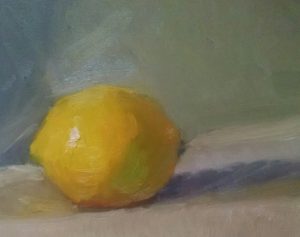10 Tips to Build a Website

 Greetings from web designer transitioning to full-time artist, Julie Dyer Holmes. If you are creative person/artist getting started with building an online presence, you may be wondering how to build an inexpensive website. Here are some tools and tips you can use to get your online presence up and running for less than $30.
Greetings from web designer transitioning to full-time artist, Julie Dyer Holmes. If you are creative person/artist getting started with building an online presence, you may be wondering how to build an inexpensive website. Here are some tools and tips you can use to get your online presence up and running for less than $30.
Tip #1
Choose your domain name and register it at iwantmyname.com. Do me a favor and choose your actual name and not ‘hotmamapaints.com’ or ‘hotdaddypaints.com’- OK? Why? Pretend you’re at a gallery opening and your paintings are everywhere. 2-weeks after your opening, your potential patron will want to remember your name and not that name you made up. You know what I’m talking about. Don’t you darling? You will find that reserving your domain name is relatively cheap (~$15 to $25 per year, give or take).
Tip #2
Create a website that makes it easy for you to add new content (images and written) as often as possible. Full disclosure, I am a WordPress fan and have chosen to work in that space for the past 8 years. If you prefer a different approach, adios for now to you then. I am not here to preach the virtues of various open source content management systems but rather to cut to the chase and suggest you get it done in WordPress.com, quickly and effectively.
Tip #3
Create an account in WordPress.com. This account is free. Woohoo! Get to know the WordPress.com Dashboard. To get to the Dashboard, click on WP-Admin and – voila – you have arrived at the Dashboard. NOTE: this is how you access the Dashboard as of May 2016. Guess what? Things change – so be sure to enlist your inner resourcefulness and click around in your new WordPress.com account. This post will give you general information about how to build your site. This post will not provide specific steps to build your site because everything in this world is so ever changing and dynamic, including WordPress.com, it doesn’t make sense to list the steps here. It’s up to you to put on your Super Resourceful Cape (Hat, Brain, etc) to make your own website happen. The Support at WordPress.com is also super helpful. Just give them time to respond to your questions. (PSSST – I will not be replying to questions here about “how to do X.” Just so you know). Everything I reference below is in the WordPress.com Dashboard. You can figure this stuff out. It’s pretty intuitive once you click around a bit in WordPress.com.
Tip #4
Create a Gravatar and include a photograph of yourself making eye contact with the camera. You will do this via your WordPress.com account.
Tip #5
If you are a visual artist, you may want to choose the (free) Cubic theme. It’s a spiffy theme that frames your images on the blog page. If you don’t like the Cubic theme, search for other themes available in WordPress.com and include your creative space in the search to narrow the options. For instance, use words such as artist, painter, photographer, writer, etc.
Tip #6
Choose 6 to 10 amazing photographs of your work and upload them (preferably all of them are the same size or at least the same aspect ratio) to the Media Library. Where is the Media Library? In your WordPress.com dashboard, of course. To keep your site loading quickly, keep your images to no more than 50KB each.
Tip #7
Create a ‘post’ using each of your 6 to 10 images (one for each post) and be sure to select ‘featured image’ within the post, too. Where do you find posts? Er, in the WordPress.com dashboard.
Tip #8
Select 5 to 10 categories for your posts and choose 2 or 3 categories for each post you create. For instance, if you are a fine artist, oil painter who loves still life paintings and figure paintings, 4 of your categories could be “fine artist,” “oil painter,” “still life paintings,” and “figure paintings.” NOTE: you can edit (change) the default ‘uncategorized” category, just know that it will appear in every post you make. Where do you find categories? You got it, in the WordPress.com dashboard.
Tip #9
Create an “About” page and upload the picture of yourself to this page and write a few words about yourself. This page will get more visits than you would believe! Even though you are setting something up on the Internet, people want to ‘see’ who you are and having a good picture and a brief (please, really, keep it brief – you know ~300 to 800 words – OK sparky?) biography adds wonderful street ‘cred’ to your website. Stated more professionally, (clearing throat and speaking with authority here): your About page will add authenticity to your website and your artwork, too. Be sure to create a menu in your WordPress.com site and save it and add your About page to the menu. This way your About page will appear in the menu bar on your spiffy new site.
Tip #10
Point your domain name that you created in iwantmyname.com to the WordPress.com name servers. When you first sign up for WordPress.com, you will see that your ‘domain name’ is joepainter.wordpress.com. If you don’t want the world to know that you have a free WordPress.com website, you can (and should) point your domain name to your spiffy new WordPress.com site you’ve built. WordPress.com has really user-friendly tips to make this happen so check out where the Dashboard shows Domains and select “Map it.” (Remember you paid ~$15 for your domain in Tip #1? Now you are going to pay ~$15 to WordPress.com to point your domain to your WordPress.com website. $15 + $15 = $30)
OK I should have entitled this blog post 11 tips to build your website but 10 tips sounded spiffier. Here’s one last tip:
Tip #11
Add social sharing to your posts in the WordPress.com dashboard. See that category entitled “Sharing”? Ya – that means you can add the capability to let a viewer share your posts by email, Facebook, Twitter, etc, etc, etc. If you are into that kind of world, add sharing. OK?
I really hope you enjoyed reading these 10 (OK 11) tips about how to build your own website in WordPress.com. As an aspiring artist myself, I confess I am not spending time building websites, rather I am drawing and painting every waking moment to pursue those beautiful moments in time and share them in realist paintings.
Interested in seeing my work? You can see a sample of it in the image entitled “Little Lemon” at the beginning of this blog post. You can see more studies and work in progress by following me on Instagram and/or get updates to this blog by signing up with your email at the box over there on the right (or below this post, if you are reading on your phone or tablet). I would love to have you comment as I progress through this journey!

2 Comments
Beth Clary
May 9, 2016Very helpful and sassy. At a recent writing conference I was naive and therefore SHOCKED to see the number of professionals that make their living managing social media for artists! Really. Their sales pitch is that it allows you, the artist, to do your art and pay a “reasonable fee” for the management of your website, FB page, Twitter, etc. So the fact that you make it sound so easy and inexpensive to do this website part is a fabulous help. Thanks, Julie!
Julie Holmes
May 9, 2016Hi Beth, The thing about any of these virtual tools is that they require some dogged persistence to figure out and implement. But then, it takes dogged persistence to be a good writer, too. Right? My hope is that you can fire up your computer, take some time to get this done and then you’ll have a tool that you can use, on your terms, not anyone else’s.
There are plenty of really capable people out there who are savvy and focussed on managing social media, as you say. It’s up to us artists to decide when these tools take too much time away from artwork/writing, etc. I want to do this kind of work myself first and then, if/when the time comes to hire someone, I’ll have an awareness of what to look for and how to manage it. For me, after drawing and painting, it’s occasional blogging, sharing on Facebook/Twitter and face-to-face interaction to back up my online presence that seem to work best for now.